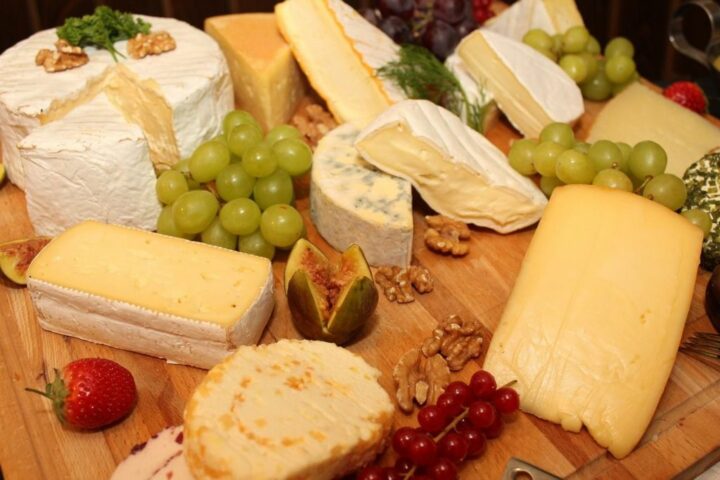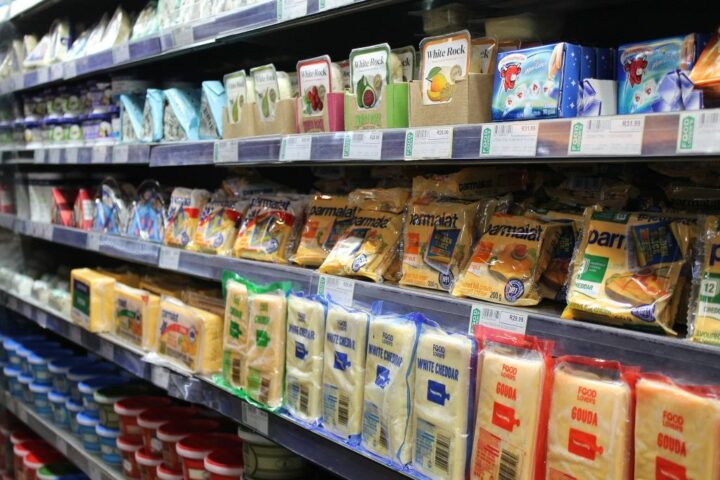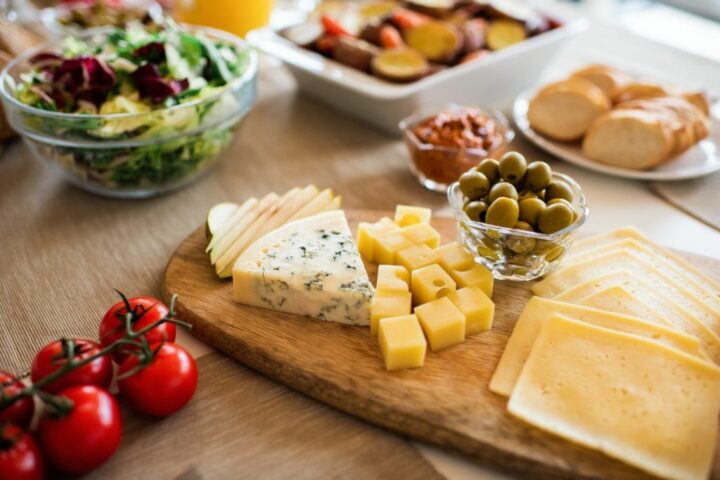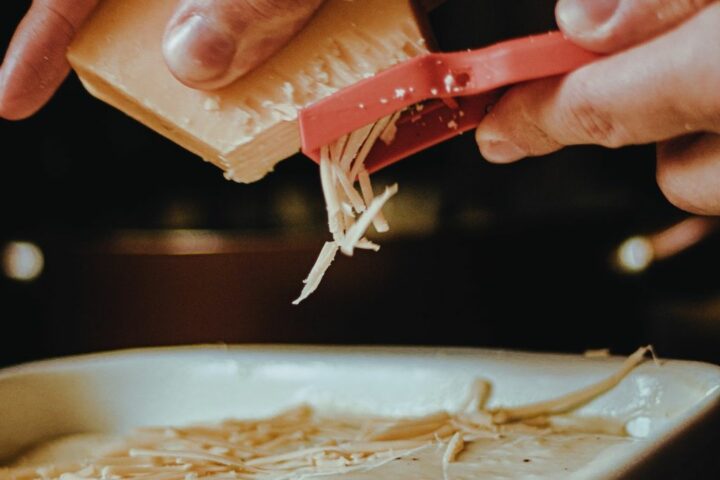Welcome, cheese enthusiasts and food lovers, to our comprehensive “Guide to Cheese”! Whether you’re a casual cheese connoisseur or a passionate fromage aficionado, this is the ultimate guide to unlocking the vast and tantalizing world of cheeses. From creamy bries to pungent blues, aged cheddars to crumbly feta, we’ll dive into the varieties, buying and storing tips, serving suggestions, cooking hints, and quick ways to incorporate cheese into your culinary adventures.

Cheese is a culinary wonder that has delighted palates for centuries. Its rich flavors, diverse textures, and incredible versatility make it an essential ingredient in countless recipes, and a delectable addition to any cheeseboard or snack platter. But with so many cheese options available, navigating the labyrinth of flavors and finding the perfect match for your palate can seem overwhelming. That’s where our guide to cheese comes in!
Types of Cheeses

When it comes to the world of cheese, there’s an astonishing array of options to explore. Each type of cheese has its own unique characteristics, flavors, and uses. In this section, we’ll delve into five distinct types of cheeses, namely natural cheeses, pasteurized process cheese, pasteurized process cheese food, pasteurized process cheese spread, and coldpack cheese. Let’s take a closer look at each of them:
1) Natural Cheese
Natural cheeses are crafted through traditional methods, typically using a combination of milk, rennet (an enzyme that aids in curdling), and salt. These cheeses undergo a natural aging process, resulting in a wide range of flavors and textures. From mild and creamy to sharp and crumbly, natural cheeses offer a diverse palette for cheese lovers. Examples of natural cheeses include cheddar, Swiss, Gouda, brie, Camembert, feta, and blue cheese. These cheeses are versatile, perfect for snacking, cooking, and pairing with other foods.
2) Pasteurized Process Cheese
Pasteurized process cheese is a type of cheese that undergoes a process where natural cheese is blended with emulsifiers, such as sodium citrate or sodium phosphate, along with heat treatment to create a smooth and uniform texture. This process allows the cheese to melt consistently without separating or becoming oily. Processed cheese like American cheese often comes in slices, blocks, or spreads and is known for its convenience and melting properties. It is commonly used in dishes like grilled cheese sandwiches, cheeseburgers, and macaroni and cheese.
3) Pasteurized Process Cheese Food
Pasteurized process cheese food is similar to pasteurized process cheese but contains additional ingredients such as cream, skim milk powder or whey. These added dairy components give the cheese food a softer and creamier texture, making it easy to spread. While it still possesses the melting qualities of processed cheese, it may have a slightly different flavor profile due to the additional ingredients. Pasteurized processed cheese food is often used as a spread on sandwiches, crackers, or as a base for dips.
4) Pasteurized Process Cheese Spread
Pasteurized process cheese spread is a soft and spreadable form of processed cheese that usually comes in jars or tubs. It has a smooth and creamy consistency, making it perfect for spreading on bread, crackers, or vegetables. This type of cheese is often flavored with various ingredients like herbs, spices, or even fruits, resulting in a wide range of delicious flavors to choose from. It is commonly used as a dip, a condiment, or as a convenient and flavorful option for quick snacks.
5) Coldpack Cheese
Coldpack cheese, also known as club cheese or crock cheese, is a type of cheese that is soft, spreadable, and typically sold in crocks or tubs. It is made by blending natural cheeses, such as cheddar or Swiss, with cream or butter. The resulting mixture is seasoned with spices, herbs, or other flavorings to create a savory and spreadable cheese. Coldpack cheese is enjoyed as a spread on crackers, bread, or used as a versatile ingredient in recipes that call for a creamy and flavorful cheese base.
With this introduction to the types of cheeses, you now have a better understanding of the diverse cheese landscape. Whether you’re indulging in natural cheeses, savoring the convenience of processed options, or enjoying the spreadable delights of coldpack cheese, each type brings its own unique charm to your culinary adventures. Get ready to explore their flavors, experiment with pairings, and uncover the endless possibilities that these cheeses offer.
Buying and Storing Cheese

When it comes to buying and storing cheese, a little knowledge can go a long way in ensuring that you enjoy the best flavors and textures from your cheese selections. From selecting the right cheeses to understanding how to store them properly, this section will provide valuable tips to enhance your cheese-buying experience and prolong the shelf life of your favorite varieties.
Selecting the Cheese
Visit Specialty Cheese Shops: For the widest variety and highest quality, consider visiting specialty cheese shops that have deep knowledge and passion for cheese. They can guide you through different options, offer samples, and provide expert recommendations based on your preferences.
Explore Farmers’ Markets: Farmers’ markets often feature artisanal cheeses made by local producers. This is an excellent opportunity to discover unique and seasonal cheeses while supporting small-scale farmers.
Supermarkets and Grocery Stores: Many supermarkets have a decent selection of cheeses, including popular varieties. While the choices might not be as extensive as specialty shops, you can still find great options for everyday use.
Assessing Cheese Freshness
Appearance: Look for cheese with a consistent texture and color. Avoid any visible signs of mold, discoloration, or excessive moisture on the surface.
Smell: Fresh cheese should have a pleasant aroma that reflects its type. However, stronger-smelling cheeses like blues or washed-rind cheeses will naturally have more pungent odors.
Texture: Gently press the cheese to check for firmness or suppleness, depending on the type. Avoid cheeses that feel excessively dry, overly soft, or crumbly unless intentional for certain varieties.
Understanding Cheese Labels
Cheese Type: Labels often indicate the cheese type, such as cheddar, Gouda, or feta. This can help you identify the flavor and texture profile you can expect.
Origin: Some cheeses are protected by geographic indications, such as Parmigiano-Reggiano or Roquefort. These labels guarantee that the cheese was produced in a specific region using traditional methods.
Aging: Labels may indicate the length of aging for certain cheeses. This information can provide insights into the flavor intensity and complexity.
Proper Cheese Storage
Cheese Wrapping: Most cheeses are best stored by wrapping them in wax or parchment paper, as this allows them to breathe and maintain the right moisture balance. Avoid using plastic wrap directly on the cheese, as it can trap moisture and promote spoilage.
Cheese Storage Container: Alternatively, you can use airtight containers or cheese vaults designed specifically for cheese storage. These containers help regulate humidity while protecting the cheese from absorbing odors from the fridge.
Refrigerator Placement: Cheese is best stored in the warmest part of the refrigerator, usually in the vegetable drawer. Avoid storing it near strong-smelling foods, as cheese easily absorbs odors.
Shelf Life and Cheese Consumption
Fresh vs. Aged Cheeses: Fresh cheeses like mozzarella or ricotta have a shorter shelf life and are best consumed within a few days of purchase. Aged cheeses, such as cheddar, Parmesan or Gruyère, can last for weeks or even months if stored properly. If mold happens to develop on hard cheeses like cheddar or parmesan, it doesn’t mean you need to throw it out. Instead, it is recommended to scrape off the mold and wipe the cheese down with a cloth soaked in a saturated salt brine solution to inhibit further mold growth and decrease the moisture in the cheese.
Moldy Rind: Some cheeses develop a natural moldy rind, such as Brie or Camembert. If the rind is white or light-colored and doesn’t have an unpleasant smell, it is safe to consume. However, if mold appears on other parts of the cheese, it is best to discard it.
Flavor Changes: Over time, cheese flavors can evolve and intensify. If you prefer milder flavors, consume the cheese earlier in its shelf life. For those who enjoy complex and robust flavors, allow the cheese to age further.
By following these buying and storing guidelines, you can ensure that your cheeses remain fresh, flavorful, and enjoyable for as long as possible. So go ahead, explore the cheese counter with confidence, and embark on a delightful journey of discovering the perfect cheeses for your palate.
Serving Tips

Most hard cheeses should be served at room temperature. This is because when cheese is chilled, it can become firm and the flavors can become muted. Allowing cheese to come to room temperature before serving can enhance the flavors and aromas, and also improve the texture. To bring cheese to room temperature, simply take it out of the refrigerator and let it sit at room temperature for about 30 minutes to an hour before serving. If you’re short on time, you can also place the cheese in a warm spot in your kitchen or microwave it for a few seconds (but be careful not to overheat it).
Some cheeses are best served chilled or cold because they have a higher moisture content and can become too soft or runny when left at room temperature. Examples of these types of cheeses include:
- Fresh cheeses like goat cheese, feta, and ricotta
- Soft-ripened cheeses like brie and camembert
- Blue cheeses like Roquefort and Gorgonzola
These cheeses are typically served chilled or cold to preserve their texture and prevent them from becoming too soft or runny. However, it’s important to note that even these cheeses should be taken out of the refrigerator about 30 minutes before serving to allow them to come to a slightly cooler than room temperature, which will enhance their flavor.
Cooking Hints

Cheese is a versatile ingredient that can add flavor, texture, and richness to a wide range of dishes. Whether you’re making a classic mac and cheese, a cheesy pizza, or a savory cheese soufflé, there are a few cooking hints that can help you get the most out of your cheese. By using high-quality cheese, grating it yourself, and adding it gradually to your dish, you can ensure that your cheese is evenly distributed and melted to perfection. In this section, we’ll share some useful cooking hints for cooking with cheese that will help you take your dishes to the next level.
Use high-quality cheese
The quality of the cheese you use can make a big difference in the final dish. Use good quality cheese that is fresh and flavorful for the best results.
Grate cheese yourself
Grating cheese yourself rather than using pre-grated cheese can improve the texture and flavor of your dish. Pre-grated cheese can contain additives that can affect the melting and flavor of the cheese.
Use cheese at room temperature
Cheese that is at room temperature will melt more evenly and smoothly than cheese that is cold. Take your cheese out of the refrigerator and let it sit at room temperature for about 30 minutes before using it in a recipe.
Add cheese gradually
When adding cheese to a dish, add it gradually and stir until it melts before adding more. This will ensure that the cheese is evenly distributed and melted throughout the dish without boiling.
Don’t overcook cheese!
Overcooking cheese can cause it to become tough and stringy. Always use low heat when melting cheese. If you can, add cheese towards the end of the cooking process and remove the dish from heat as soon as the cheese is melted and evenly distributed.
The best oven temperature when baking cheese dishes depends on the specific recipe you’re using. In general, most cheese dishes are baked at a temperature of 350°F to 375°F (175°C to 190°C). This temperature allows the cheese to melt and brown evenly without burning. However, some recipes may call for a higher or lower temperature depending on the ingredients and cooking time. It’s important to follow the recipe instructions carefully to ensure that your cheese dish turns out perfectly. If you’re unsure about the best temperature for your recipe, you can always check the recipe or consult a cooking guide for advice.
When broiling cheese, it’s important to keep a close eye on it to prevent it from burning. Cheese can go from melted and gooey to burnt and crispy very quickly under the broiler. To prevent this, place the dish under the broiler for only a few minutes at a time and check it frequently. If the cheese starts to brown too quickly, move the dish to a lower rack or turn off the broiler and finish cooking the dish in the oven. Additionally, you can cover the dish with foil or parchment paper to prevent the cheese from burning while it melts.
Experiment with different types of cheese
Different types of cheese can add different flavors and textures to a dish. Experiment with different types of cheese to find the perfect combination for your recipe.
Quick and Easy Cheese Recipes
Cheese is a versatile ingredient that can be used in a variety of dishes, from classic mac and cheese to cheesy quesadillas and grilled cheese sandwiches. One of the best things about cheese is that it can be used to create quick and easy meals that are perfect for busy weeknights or lazy weekends. In this section, we’ve compiled a list of quick and easy cheese recipes that can be made in just a few minutes with minimal ingredients. Whether you’re in the mood for a cheesy salad, a gooey grilled cheese sandwich, or a simple quesadilla, these quick and easy recipes are sure to satisfy your cheese cravings in no time.
Cheesy Quesadillas: Place a tortilla in a nonstick skillet over medium heat, sprinkle shredded cheese on one half of the tortilla, fold the other half over the cheese, and cook for 2-3 minutes on each side until the cheese is melted and the tortilla is crispy. Serve with salsa and guacamole.
Caprese Salad: Slice fresh mozzarella cheese and tomatoes, arrange them on a plate, drizzle with olive oil and balsamic vinegar, and sprinkle with salt, pepper, and fresh basil leaves.
Grilled Cheese Sandwich: Spread butter on one side of two slices of bread, place a slice of cheese between the bread slices (buttered side facing out), and cook in a nonstick skillet over medium heat for 2-3 minutes on each side until the bread is golden brown and the cheese is melted.
Enjoy your cheese!
Cheese is a versatile and beloved ingredient that brings immense pleasure to our palates. Whether you’re a cheese connoisseur or a casual cheese enthusiast, understanding the different types of cheeses, buying and storing them properly, mastering the art of serving, and exploring creative ways to enjoy cheese can enhance your culinary experiences. From the rich and complex flavors of natural cheeses to the convenience of processed cheese options, there’s a cheese to suit every taste and occasion.
So, go ahead and embark on your cheese journey, savoring the diverse textures, aromas, and tastes that this beloved dairy delight has to offer. Whether you’re enjoying it as a centerpiece on a cheese board, adding a touch of indulgence to your cooking, or simply relishing a quick and easy cheese snack, cheese is sure to bring joy and satisfaction to your culinary adventures. So, grab your favorite cheese knife, savor each bite, and let the world of cheese captivate your taste buds.
Please SHARE this handy guide to cheese with your friends and family.






